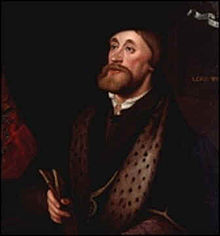Thomas Wriothesley, 1st Earl of Southampton

Thomas Wriothesley, 1st Earl of Southampton, KG (21 December 1505[1] – 30 July 1550[2]), known as The Lord Wriothesley (pronounced "Risley") between 1544 and 1547, was a politician of the Tudor period born in London to William Wrythe and Agnes Drayton.
Entering the service of Thomas Cromwell and Cardinal Thomas Wolsey at an early age, Wriothesley soon made himself very useful to his masters, and he was richly rewarded when the monasteries were dissolved, obtaining extensive lands between Southampton and Winchester. By May, 1530, he was a clerk of the Signet.[3]Until May, 1539, he was Henry's ambassador in Brussels. [4]
Having been on errands abroad, he was made one of the king's principal secretaries in 1540 (a position he held jointly with Sir Ralph Sadler), and was knighted in the same year; in spite of the fall of his patron, Thomas Cromwell, he rose higher and higher in the royal favour, and in 1542 it was said that he governed almost everything in England. He sought to bring about an alliance between England and Spain in 1543, and was created Baron Wriothesley of Titchfield in 1544.
Having been Lord Privy Seal for a few months, he became Lord Chancellor in 1544, in which capacity he became notorious for his persecution of Anne Askew; Askew alleged that he operated the rack on which she was tortured.[5] Certainly he was one of the executors of Henry's will, and in accordance with the dead king's wishes he was created Earl of Southampton on 16 February 1547. However, he had been incautious enough to appoint four persons to relieve him of his duties as Lord Chancellor, and advantage was taken of this to deprive him of his office in March, when he also ceased to be a member of the Privy Council.
Later he was readmitted to the Council, and he took a leading part in bringing about the fall of Edward Seymour, 1st Duke of Somerset, but he had not regained his former position when he died. His successor in the earldom was his son, Henry.
He married Jane Cheney and they had four children:
- William Wriothesley (born before 12 September 1535 and died in August of 1537)
- Anthony Wriothesley (born and died an infant in 1542)
- Elizabeth Wriothesley (b. abt. 1536 and died in 1554, was buried 16 January 1554; she married as his first wife Thomas Radclyffe, 3rd Earl of Sussex, before 1 November 1545, without issue.
- Henry Wriothesley, 2nd Earl of Southampton (Christened 24 April 1545 – 4 October 1581; he married Mary Browne
References
- ^ Karen Lindsey, Divorced, Beheaded, Survived, xviii, Perseus Books, 1995
- ^ Karen Lindsey, Divorced, Beheaded, Survived, xviii, Perseus Books, 1995
- ^ G. R. Elton, The Tudor Revolution in Government (Cambridge: Cambridge University Press, 1953) p. 308ff.
- ^ http://www.british-history.ac.uk/report.aspx?compid=88015
- ^ Alison Weir, The Six Wives of Henry VIII, Pimlico Books, 1992
- tudorplace.com.ar Accessed 4 December 2007
- Burke, John. A General and Heraldic Dictionary of the Peerages of England, Ireland, and Scotland, Extinct, Dormant, and in Abeyance. London: H. Colburn and R. Bentley, 1831. googlebooks
- This article incorporates text from a publication now in the public domain: Chisholm, Hugh, ed. (1911). Encyclopædia Britannica (11th ed.). Cambridge University Press.
{{cite encyclopedia}}: Missing or empty|title=(help)
